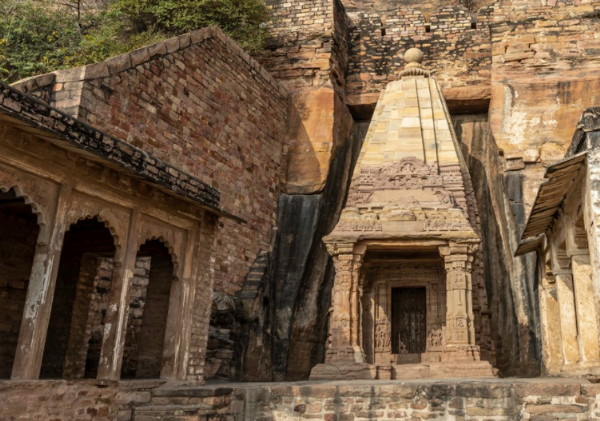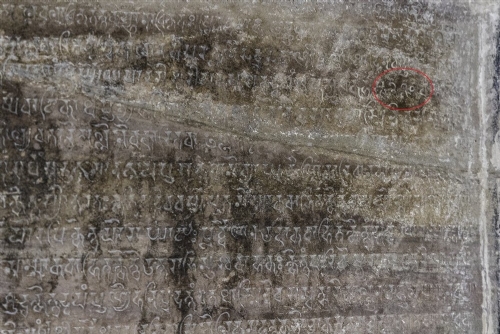Chaturbhuj Temple, hosting the world’s ‘oldest’ carved zero
30 Mar 2022 16:22:49
Every history buff is sure to have visited the cultural center of Gwalior, in the heart of India. Once reigned by Rajput dynasty of Tomars, it was passed on to the Mughal empire under Babur’s rule in the 16th century. Built on Gopachal Parvat, the fort has many impressive architectural elements that are reflected in its palaces & temples.

Romans had letters to represent numbers, the largest being M which represented 1,000. Hence, if you wanted to indicate the number 10000 in Roman numerals, you would right MMMMMMMMMM - a confusing system, definitely one prone to errors. India created a system where the place of the number can determine what its value is.
We can see the inscription inside the temple, the number “270” circled in red. The inscription records the date as 876 AD.

Hasta is a traditional unit of India to measure the length. From the elbow to the tip of the middle finger articles about 8 inches or 45 cm. See guys that how similar the numbers looked to how 270 written today.
While there was an understanding of nothingness in the ancient Babylonian and Chinese culture, it was in India that mathematicians put a symbol, the circle for it.
Until quite recently it was believed the Zero at the Gwalior Fort was the oldest known inscription of zero in the world. Then in 1931 a French archaeologist, Georges Cœdès, deciphered a plaque found in the ruins of a 7th century temple in Cambodia.
The earliest recorded use of zero on any medium in India, was found on the Bakhshali manuscript. The Bakhshali manuscript was discovered in 1881, buried in a field in what was then an Indian village called Bakhshali.
The Bakhshali manuscript, now in the University of Oxford’s Bodleian Library, was broadly recognised as the oldest Indian mathematical text, but it’s exact age had been widely contested. Recent radiocarbon dating of the manuscript has placed its date to the 3rd century AD predating the Gwalior zero inscription by 500 years. The decimal numbering system features heavily in this document, is does the number '0' written as a circle.

Carved into a sheer rock face, the Chaturbhuj temple, also known as the temple of the 4-armed Lord, stands to the east of the Gwalior Fort. Dedicated to Lord Vishnu, the temple is said to have been constructed in 876 BC.
It is most famous for the world’s oldest known zero inscribed into stone. Inside the temple, there is an idol of Lord Vishnu and the inscription with zero. There are two figures of zero inscribed and the custodian of the temple. While the eastern approach to the fort is tough, and the cobbled path can't be traversed by car, one can also come down halfway from the top of the fort to see the temple.
Thanks to an inscription in the sanctum, we know for sure that the temple was constructed in the year 876 AD. It is the same inscription that also contains one of the earliest known uses of the mathematical number zero (0). India is where the decimal numbering system based on position was invented.
Romans had letters to represent numbers, the largest being M which represented 1,000. Hence, if you wanted to indicate the number 10000 in Roman numerals, you would right MMMMMMMMMM - a confusing system, definitely one prone to errors. India created a system where the place of the number can determine what its value is.
Also Read | Kashi Vishweshwar Mandir, the embodiment of simplicity in Wai
There are 2 examples of the use of zero on the inscription in the sanctum, located to the left of a now damaged Vishnu idol. We'll only able to successfully identify one of the zeros. Here is Vishnu in the sanctum, with the inscription containing 0 in the background.
We can see the inscription inside the temple, the number “270” circled in red. The inscription records the date as 876 AD.

The inscription says: “Om. Adoration to Vishnu! In the year 933 [876], on the second day of the bright half of the month of Magha the whole town gave to the temple which Alla, the son of Vaillabhatta, had caused to be built a piece of land 270 hastas in length and 187 hastas in breadth, for a flower garden the town gave in perpetual endowment for a daily gift of 50 garlands of flowers.”
Hasta is a traditional unit of India to measure the length. From the elbow to the tip of the middle finger articles about 8 inches or 45 cm. See guys that how similar the numbers looked to how 270 written today.
While there was an understanding of nothingness in the ancient Babylonian and Chinese culture, it was in India that mathematicians put a symbol, the circle for it.
Until quite recently it was believed the Zero at the Gwalior Fort was the oldest known inscription of zero in the world. Then in 1931 a French archaeologist, Georges Cœdès, deciphered a plaque found in the ruins of a 7th century temple in Cambodia.
Also Read | Mata Vaishno Devi Temple, the holy Shakti Peeth of Durga Mata
The plaque was dated to 683 AD, predating the Gwalior zero by 193 years. The inscription was moved to the Cambodian National Museum from where it ‘disappeared’ during the Khmer Rouge regime. For a time, the Gwalior Zero regained its title as the world’s oldest zero. Then in January 2017, it was announced that the Cambodian National Museum had found their lost artifact, and it was going to be put on public display. The Gwalior Zero was then relegated back to second place.
The earliest recorded use of zero on any medium in India, was found on the Bakhshali manuscript. The Bakhshali manuscript was discovered in 1881, buried in a field in what was then an Indian village called Bakhshali.
The Bakhshali manuscript, now in the University of Oxford’s Bodleian Library, was broadly recognised as the oldest Indian mathematical text, but it’s exact age had been widely contested. Recent radiocarbon dating of the manuscript has placed its date to the 3rd century AD predating the Gwalior zero inscription by 500 years. The decimal numbering system features heavily in this document, is does the number '0' written as a circle.